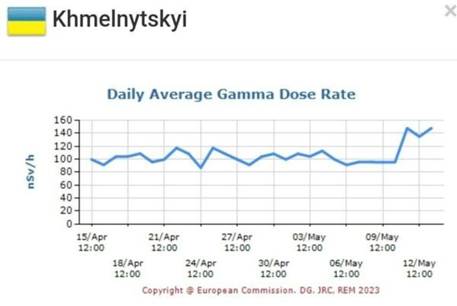On Saturday, during a massive air and missile raid on Ukraine, Russian forces hit a ammunition depot in Khmelnytsky, in the western part of the country, causing gigantic explosions in the site.
“It is worth noting that panic reports are spreading in Ukrainian social networks that during the detonation of an ammunition depot in Khmelnytsky, a large batch of British tank ammunition with depleted uranium, which was recently brought to Ukraine along with Storm Shadow missiles, was also destroyed. As a result of a huge explosion, particles of depleted uranium could be dispersed on the territory of the Khmelnytsky region, which, taking into account the experience of Yugoslavia and Iraq, could lead to an outbreak of cancer in the medium term.”
It didn’t take long for the results of the impact to be measurable scientifically.

Slavyangrad on Telegram:
“A clear spike in gamma radiation was detected in Khmelnitsky on or about May 12th, with emission continuing to rise the following day and remaining at the elevated level thereafter.
Considering how little gamma radiation comes from depleted uranium, this clear spike in gamma radiation in Khmelnitsky indicates that there was very large stockpile of the DU munitions that was destroyed, raising the uranium dust into the air.
By comparison, the towns of Ternopol, Khmilnik, and Novaya Ushitsa remained at their apparent regular, base levels. This indicates that the Khmelnitsky anomaly is indeed a spike and corroborates the claim that the stockpile in Khmelnitsky contained DU munitions.”
While the UK authorities dismissed the danger posed by this kinds of shells, the experience in Yugoslavia and Iraq has shown how deadly in the medium term these vaporized depleted uranium shells can be.
